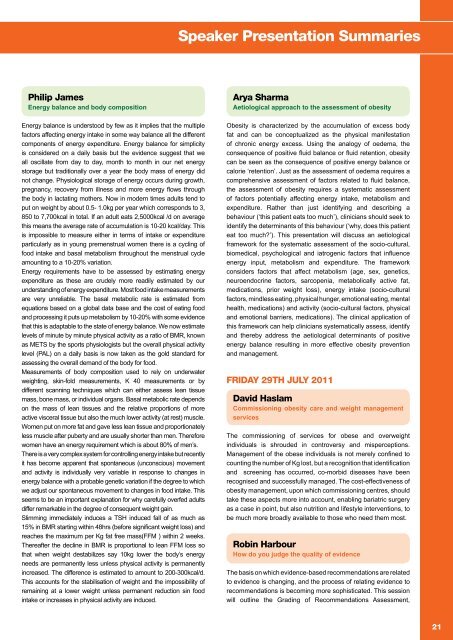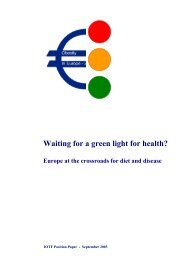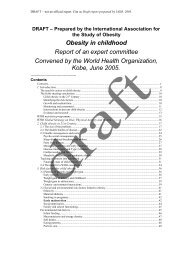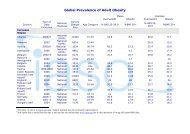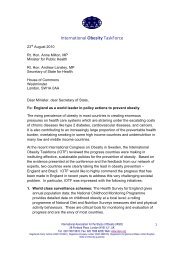COURSE GUIDE - International Association for the Study of Obesity
COURSE GUIDE - International Association for the Study of Obesity
COURSE GUIDE - International Association for the Study of Obesity
Create successful ePaper yourself
Turn your PDF publications into a flip-book with our unique Google optimized e-Paper software.
Speaker Presentation SummariesPhilip JamesEnergy balance and body compositionEnergy balance is understood by few as it implies that <strong>the</strong> multiplefactors affecting energy intake in some way balance all <strong>the</strong> differentcomponents <strong>of</strong> energy expenditure. Energy balance <strong>for</strong> simplicityis considered on a daily basis but <strong>the</strong> evidence suggest that weall oscillate from day to day, month to month in our net energystorage but traditionally over a year <strong>the</strong> body mass <strong>of</strong> energy didnot change. Physiological storage <strong>of</strong> energy occurs during growth,pregnancy, recovery from illness and more energy flows through<strong>the</strong> body in lactating mo<strong>the</strong>rs. Now in modern times adults tend toput on weight by about 0.5- 1.0kg per year which corresponds to 3,850 to 7,700kcal in total. If an adult eats 2,5000kcal /d on averagethis means <strong>the</strong> average rate <strong>of</strong> accumulation is 10-20 kcal/day. Thisis impossible to measure ei<strong>the</strong>r in terms <strong>of</strong> intake or expenditureparticularly as in young premenstrual women <strong>the</strong>re is a cycling <strong>of</strong>food intake and basal metabolism throughout <strong>the</strong> menstrual cycleamounting to a 10-20% variation.Energy requirements have to be assessed by estimating energyexpenditure as <strong>the</strong>se are crudely more readily estimated by ourunderstanding <strong>of</strong> energy expenditure. Most food intake measurementsare very unreliable. The basal metabolic rate is estimated fromequations based on a global data base and <strong>the</strong> cost <strong>of</strong> eating foodand processing it puts up metabolism by 10-20% with some evidencethat this is adaptable to <strong>the</strong> state <strong>of</strong> energy balance. We now estimatelevels <strong>of</strong> minute by minute physical activity as a ratio <strong>of</strong> BMR, knownas METS by <strong>the</strong> sports physiologists but <strong>the</strong> overall physical activitylevel (PAL) on a daily basis is now taken as <strong>the</strong> gold standard <strong>for</strong>assessing <strong>the</strong> overall demand <strong>of</strong> <strong>the</strong> body <strong>for</strong> food.Measurements <strong>of</strong> body composition used to rely on underwaterweighting, skin-fold measurements, K 40 measurements or bydifferent scanning techniques which can ei<strong>the</strong>r assess lean tissuemass, bone mass, or individual organs. Basal metabolic rate dependson <strong>the</strong> mass <strong>of</strong> lean tissues and <strong>the</strong> relative proportions <strong>of</strong> moreactive visceral tissue but also <strong>the</strong> much lower activity (at rest) muscle.Women put on more fat and gave less lean tissue and proportionatelyless muscle after puberty and are usually shorter than men. There<strong>for</strong>ewomen have an energy requirement which is about 80% <strong>of</strong> men’s.There is a very complex system <strong>for</strong> controlling energy intake but recentlyit has become apparent that spontaneous (unconscious) movementand activity is individually very variable in response to changes inenergy balance with a probable genetic variation if <strong>the</strong> degree to whichwe adjust our spontaneous movement to changes in food intake. Thisseems to be an important explanation <strong>for</strong> why carefully overfed adultsdiffer remarkable in <strong>the</strong> degree <strong>of</strong> consequent weight gain.Slimming immediately induces a TSH induced fall <strong>of</strong> as much as15% in BMR starting within 48hrs (be<strong>for</strong>e significant weight loss) andreaches <strong>the</strong> maximum per Kg fat free mass(FFM ) within 2 weeks.Thereafter <strong>the</strong> decline in BMR is proportional to lean FFM loss sothat when weight destabilizes say 10kg lower <strong>the</strong> body’s energyneeds are permanently less unless physical activity is permanentlyincreased. The difference is estimated to amount to 200-300kcal/d.This accounts <strong>for</strong> <strong>the</strong> stabilisation <strong>of</strong> weight and <strong>the</strong> impossibility <strong>of</strong>remaining at a lower weight unless permanent reduction sin foodintake or increases in physical activity are induced.Arya SharmaAetiological approach to <strong>the</strong> assessment <strong>of</strong> obesity<strong>Obesity</strong> is characterized by <strong>the</strong> accumulation <strong>of</strong> excess bodyfat and can be conceptualized as <strong>the</strong> physical manifestation<strong>of</strong> chronic energy excess. Using <strong>the</strong> analogy <strong>of</strong> oedema, <strong>the</strong>consequence <strong>of</strong> positive fluid balance or fluid retention, obesitycan be seen as <strong>the</strong> consequence <strong>of</strong> positive energy balance orcalorie ‘retention’. Just as <strong>the</strong> assessment <strong>of</strong> oedema requires acomprehensive assessment <strong>of</strong> factors related to fluid balance,<strong>the</strong> assessment <strong>of</strong> obesity requires a systematic assessment<strong>of</strong> factors potentially affecting energy intake, metabolism andexpenditure. Ra<strong>the</strong>r than just identifying and describing abehaviour (‘this patient eats too much’), clinicians should seek toidentify <strong>the</strong> determinants <strong>of</strong> this behaviour (‘why, does this patienteat too much?’). This presentation will discuss an aetiologicalframework <strong>for</strong> <strong>the</strong> systematic assessment <strong>of</strong> <strong>the</strong> socio-cultural,biomedical, psychological and iatrogenic factors that influenceenergy input, metabolism and expenditure. The frameworkconsiders factors that affect metabolism (age, sex, genetics,neuroendocrine factors, sarcopenia, metabolically active fat,medications, prior weight loss), energy intake (socio-culturalfactors, mindless eating, physical hunger, emotional eating, mentalhealth, medications) and activity (socio-cultural factors, physicaland emotional barriers, medications). The clinical application <strong>of</strong>this framework can help clinicians systematically assess, identifyand <strong>the</strong>reby address <strong>the</strong> aetiological determinants <strong>of</strong> positiveenergy balance resulting in more effective obesity preventionand management.FRIDAY 29TH JULY 2011David HaslamCommissioning obesity care and weight managementservicesThe commissioning <strong>of</strong> services <strong>for</strong> obese and overweightindividuals is shrouded in controversy and misperceptions.Management <strong>of</strong> <strong>the</strong> obese individuals is not merely confined tocounting <strong>the</strong> number <strong>of</strong> Kg lost, but a recognition that identificationand screening has occurred, co-morbid diseases have beenrecognised and successfully managed. The cost-effectiveness <strong>of</strong>obesity management, upon which commissioning centres, shouldtake <strong>the</strong>se aspects more into account, enabling bariatric surgeryas a case in point, but also nutrition and lifestyle interventions, tobe much more broadly available to those who need <strong>the</strong>m most.Robin HarbourHow do you judge <strong>the</strong> quality <strong>of</strong> evidenceThe basis on which evidence-based recommendations are relatedto evidence is changing, and <strong>the</strong> process <strong>of</strong> relating evidence torecommendations is becoming more sophisticated. This sessionwill outline <strong>the</strong> Grading <strong>of</strong> Recommendations Assessment,21


